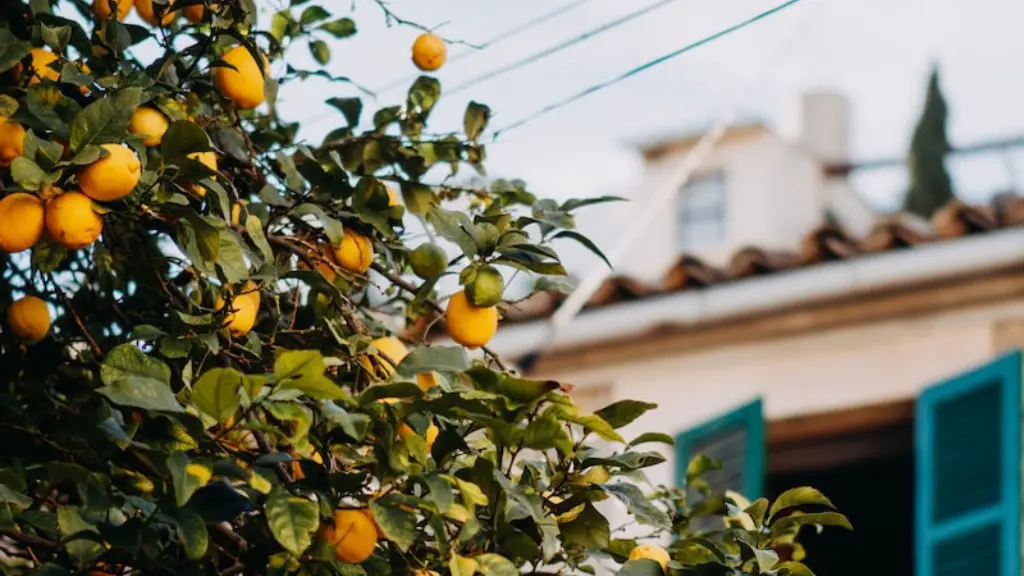Frost damage to lemon trees is a common problem for citrus growers, but there are ways to minimize the effects of ice and restore the health of the trees. Here are the steps on how to save a frost damaged lemon tree:
1. Firstly, identify if your lemon tree has been affected by frost. Symptoms of frost damage include discoloured leaves, damaged shoots, and the deadening of flower buds. You can also examine the twigs and branches of the tree and look for splitting or cracking.
2. You should then prune the affected branches and twigs. Do not prune all of them as this could significantly decrease the tree’s vigour and health. Pruning is best done two weeks after the frost has passed.
3. Once you have identified and pruned the frost damaged branches, you should fertilize your lemon tree with a balanced organic fertilizer. This will help the tree to recover from the frost damage quicker.
4. You should also mulch your lemon tree. Mulch should be applied in a ring around the tree’s base and should be kept to a depth of around four inches. Mulch will help to keep the soil from forming patches of frost.
5. You should also provide the lemon tree with extra moisture. If your lemon tree was exposed to the extreme cold, the soil will be affected, so you should water the tree with a long slow watering once or twice per week. This will help to keep the soil moist, increasing the rate of recovery.
6. You should also protect your lemon tree from further frost damage. The best way of doing this is to cover the tree in a protective cover or tarp. You can also place heat lamps near the tree or wrap it with blankets. This will provide enough protection if the temperature drops below freezing.
7. Moreover, you should always keep an eye on the weather. To provide your lime tree with the best protection from frost damage, you should be aware of any predicted frost and be prepared to take action.
What Are Some Further Tips?
It is important to bear in mind that the effects of frost damage can linger. Even after pruning the affected branches, fertilizing, mulching, or protecting the lemon tree, there will still be damage caused by the frost. To ensure the best outcome, there are a few further steps that you can take:
1. You should check your tree for any fungal infections that may have been caused by the frost. If the weather is damp, there is an increased chance of fungal infection in the tree, and you should treat this accordingly.
2. You should give your tree some extra care. Lemon trees that have been damaged by frost are more susceptible to disease, pests, and further frost damage. It is important to give the tree some extra attention, so that it can recover as quickly and efficiently as possible.
3. You should watch out for signs of regrowth. It is important to be patient and watch carefully for signs of regrowth in your lemon tree as this can indicate that it is on the road to recovery. If you see signs of new growth on the tree, it is a good indicator that it is healing itself.
4. Finally, you should remove any signs of decay. Even after taking all of the precautionary steps, it is possible that the tree may still have some signs of rot or decay. If you do find any, it is important to remove them immediately.
What Are Some Long Term Solutions?
The best way to protect your lemon trees from frost damage is to be prepared in advance. This could involve planting the trees in moderately exposed areas, ensuring adequate irrigation is in place, and understanding local weather conditions. Here are some long term solutions to help protect your lemon tree from frost damage:
1. You should select your location carefully. Frost damage is more likely in frost pockets, so you should choose an area that is not exposed to the extremes of cold. If there is no way to avoid a frost pocket, you can cover your tree with burlap.
2. You should also ensure your tree has adequate irrigation. This helps to ensure that the tree’s root system is healthy and thriving. You can also use irrigation to help protect the tree from frost damage.
3. You should also establish a rootstock barrier. This allows the tree to be more resistant to the weather conditions and is especially helpful in colder climates. This can be done by lightly pruning the tree’s branches and ensuring that the rootstock is not exposed.
4. You should also provide wind protection for the lemon tree. If there is a lot of wind in the area, you can use a windbreak or wind fence to help protect your lemon tree. This will help to keep the winds from damaging the tree’s branches and foliage.
5. Finally, you should understand the local weather patterns. You should always be aware of the local temperatures and know when the weather is going to turn cold. This allows you to prepare for any predicted frost and reduce the risk of damage to your tree.
How Can I Keep My Tree Healthy After Frost Damage?
Once you have identified and treated any frost damage to your lemon tree, there are a few steps that you can take to keep it healthy. Here are some tips on how to keep your tree healthy after frost damage:
1. You should monitor the tree closely. Keep an eye out for any discolouration or damage and take action immediately. If the frost has caused significant damage, consider removing the affected branches.
2. You should prune correctly. Prune your tree correctly to ensure that the tree is structurally sound and can continue to absorb enough sunlight. Prune away any dead branches, and also thin inside branches to increase air circulation.
3. You should give the tree extra care. Lemon trees require more attention after frost damage. This includes ensuring that the tree is watered regularly, and that it is receiving enough nutrients, sunlight, and warm temperatures.
4. You should test the soil. Test the soil regularly to make sure it is not too acidic. The ideal pH for lemon trees is around 6.5 to 7.5, so if you find your soil is too acidic, apply an organic fertilizer to correct the pH.
5. You should watch out for pests and diseases. Frost damaged trees are more susceptible to pests and diseases, so watch out for signs of attack and take the necessary steps to eradicate the problem.
How Can I Prevent Frost Damage?
The best way to prevent frost damage to your lemon tree is to be aware of the local weather conditions and to prepare for any predicted frost. Here are some tips on how to do this:
1. You should understand your climate. It is important to understand the specifics of your climate, such as when the worst frosts usually occur, to ensure that you are prepared in advance.
2. You should cover your tree. If you have an outdoor lemon tree, use covers to protect it from the cold. Thicker fabrics such as burlap or canvas are the most effective and will help to keep the tree warm.
3. You should also plan ahead. If you think that a frost is coming, you can take steps to protect your tree from the cold. Make sure to prune the tree, mulch well, and keep the soil moist.
4. You should know when to act. The best way to prevent frost damage is to act as soon as possible. If you notice that the temperature is dropping and the air is still, immediately take the necessary steps to protect your tree.
5. Finally, you should take extra care in winter. During the frost period, be more attentive to your tree and keep a check on its health. Additional irrigation and mulch are good ways to keep the tree healthy and warm.





